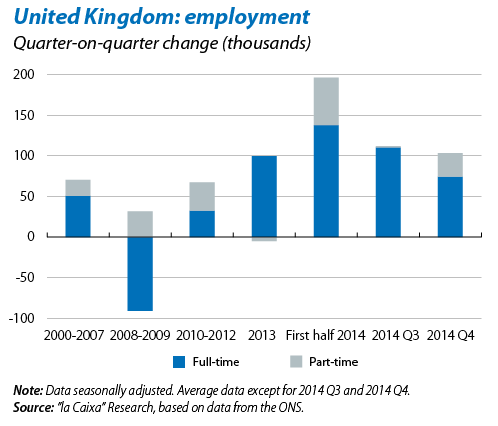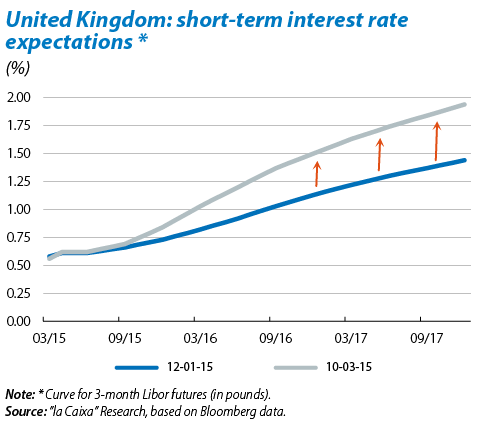GDP has been growing by over 2% for more than a year now and the bulk of the evidence suggests that it will remain at similar levels in 2015 and 2016. The output gap (i.e. the difference between real and potential output, which reached –3% in 2012 according to the IMF) will almost be closed this year. Historically, such a situation increases pressure on prices and monetary policy therefore tends to react by tightening up financial conditions (or at least by becoming less accommodative). Another sign that spare productive capacity is already very limited are the good figures posted by the labour market. Unemployment fell to 5.9% in 2014 Q4, clearly below its historical average of 6.8%. Moreover a large part of this increase in employment corresponded to full-time contracts, indicating growing confidence that the expansionary cycle will continue for some time. Such changes in the labour market should lead to wage rises. In this respect, it is significant that the growth rate for wages was 1.7% year-on-year in 2014 Q4 (1.2% in Q3), breaking the downward slide starting in 2008.

However, although data on economic activity have been surprisingly good in general, inflation has been surprisingly low in the last few quarters. The sharp drop in inflation, standing at 0.0% in February, has not been due merely to the fall in oil prices as core inflation has also shown a marked downward trend over the last few months. The pound's appreciation is playing an important role in this respect. Although inflation is likely to recover in the next few months, the absence of inflationary pressure introduces a large degree of uncertainty regarding the point when monetary policy should start to change its tune.
And as if the scenario were not complex enough already, the BoE must also bear in mind the effect of monetary policy on financial stability. The main concern in this area is the trend in house prices, up by 10% last year. The BoE is trying to contain the possible formation of another property bubble by limiting the amount of mortgage risk banks are allowed to take on.1 However, as Mark Carney has repeated on numerous occasions, the emergence of a new housing bubble is still one of the main threats to the United Kingdom's stability in the medium term.

In short, monetary policy will be the main focus of debate in the United Kingdom over the coming months. If inflation starts to pick up, as is expected, then discussion regarding the rate of interest rate hikes will also be lively. And if it does not pick up, forcing the BoE to maintain its current accommodative tone, then debate will focus on whether the pressure on house prices can be slowed up in such an environment.
Recommended Content
Editors’ Picks
EUR/USD clings to gains above 1.0750 after US data

EUR/USD manages to hold in positive territory above 1.0750 despite retreating from the fresh multi-week high it set above 1.0800 earlier in the day. The US Dollar struggles to find demand following the weaker-than-expected NFP data.
GBP/USD declines below 1.2550 following NFP-inspired upsurge

GBP/USD struggles to preserve its bullish momentum and trades below 1.2550 in the American session. Earlier in the day, the disappointing April jobs report from the US triggered a USD selloff and allowed the pair to reach multi-week highs above 1.2600.
Gold struggles to hold above $2,300 despite falling US yields

Gold stays on the back foot below $2,300 in the American session on Friday. The benchmark 10-year US Treasury bond yield stays in negative territory below 4.6% after weak US data but the improving risk mood doesn't allow XAU/USD to gain traction.
Bitcoin Weekly Forecast: Should you buy BTC here? Premium

Bitcoin (BTC) price shows signs of a potential reversal but lacks confirmation, which has divided the investor community into two – those who are buying the dips and those who are expecting a further correction.
Week ahead – BoE and RBA decisions headline a calm week

Bank of England meets on Thursday, unlikely to signal rate cuts. Reserve Bank of Australia could maintain a higher-for-longer stance. Elsewhere, Bank of Japan releases summary of opinions.